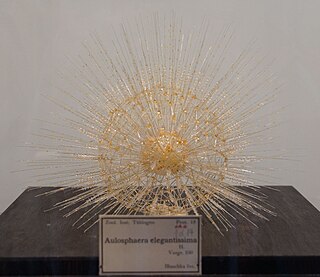
Ostracods, or ostracodes, are a class of the Crustacea, sometimes known as seed shrimp. Some 70,000 species have been identified, grouped into several orders. They are small crustaceans, typically around 1 mm (0.039 in) in size, but varying from 0.2 to 30 mm in the case of Gigantocypris. Their bodies are flattened from side to side and protected by a bivalve-like, chitinous or calcareous valve or "shell". The hinge of the two valves is in the upper (dorsal) region of the body. Ostracods are grouped together based on gross morphology. While early work indicated the group may not be monophyletic and early molecular phylogeny was ambiguous on this front, recent combined analyses of molecular and morphological data found support for monophyly in analyses with broadest taxon sampling.

Vargulin, also called Cypridinid luciferin, Cypridina luciferin, or Vargula luciferin, is the luciferin found in the ostracod Cypridina hilgendorfii, also named Vargula hilgendorfii. These bottom dwelling ostracods emit a light stream into water when disturbed presumably to deter predation. Vargulin is also used by the midshipman fish, Porichthys.

Aulosphaera is a genus of Cercozoa. The genus contains bioluminescent species. It one of two known bioluminescent phaeodarean genera, the other being Tuscaridium. The described bioluminescent species is Aulosphaera triodon Haeckel, 1887.
Swima bombiviridis is a worm species that lives in the deep ocean. It is also known as the green bomber worm, green bomber worm, or bombardier worm. This deep ocean pelagic (free-swimming) annelid has modified bioluminescent gills that can be cast off from an individual. These discarded gills somewhat resemble green "bombs" that remain illuminated for several seconds after they have been discarded. It is thought that this is a defensive mechanism rather than reproductive, as it is seen in both mature and juvenile individuals. This species was the first of its genus, Swima, to be discovered, and was the only one with a formal scientific name as of 2010. The genus name, Swima, is derived from the Latin, referring to the animal's ability to swim. The species name, bombiviridis, is derived from the Latin prefix bombus, meaning humming or buzzing, and the suffix viridis, which is Latin for the color green. Swima bombiviridis therefore translates to "swimming green bomber".

Quantula striata, also known as Dyakia striata, is a species of medium-sized, air-breathing, tropical land snail. It is a terrestrial, pulmonate, gastropod mollusk in the family Dyakiidae. This species appears to be unique among terrestrial gastropods in that it is bioluminescent: Its eggs glow in the dark, and juveniles and most adults give off flashes of green light. It is the only species in the genus Quantula.

Cypridinidae is a family of ostracods, containing the following genera:

Vargula hilgendorfii, sometimes called the sea-firefly and one of three bioluminescent species known in Japan as umi-hotaru (海蛍), is a species of ostracod crustacean. It is the only member of genus Vargula to inhabit Japanese waters; all other members of its genus inhabit the Gulf of Mexico, the Caribbean Sea, and waters off the coast of California. V. hilgendorfii was formerly more common, but its numbers have fallen significantly.

John Woodland "Woody" Hastings, was a leader in the field of photobiology, especially bioluminescence, and was one of the founders of the field of circadian biology. He was the Paul C. Mangelsdorf Professor of Natural Sciences and Professor of Molecular and Cellular Biology at Harvard University. He published over 400 papers and co-edited three books.

Porichthys notatus is a species of batrachoid toadfish. It is a member of the midshipman genus, Porichthys, and is known by the common name plainfin midshipman. It is native to the eastern Pacific Ocean, where its distribution extends along the coast from Sitka, Alaska, to Magdalena Bay in southern Baja California.
Thalassicolla is a radiolarian genus reported in the Thalassicollidae. The genus contains bioluminescent species. It is a genus of solitary radiolarians.
Photeros is a genus in the Cypridinidae. The genus contains bioluminescent species, and is one of the genera of bioluminescent ostracods which show stereotyped bioluminescent mating signals.
Enewton is a genus in the family Cypridinidae. The genus contains bioluminescent species, and in particular is one of the Caribbean genera of bioluminescent ostracods that perform stereotyped bioluminescent mating displays.

Vargula is a genus in the Cypridinidae. The genus contains bioluminescent species. Vargula hilgendorfii, native to Japan, is likely the best-studied Vargula species. Some species currently within Vargula may be split into their own genus.
Tuscaridium is a genus of phaeodarian,. The genus contains bioluminescent species. It one of two known bioluminescent phaeodarean genera, the other being Aulosphaera.
Cypridopsis is a genus of ostracods, belonging to the family Cyprididae.
Physocypria is a genus of ostracods belonging to the family Candonidae. The species of this genus are found in Europe, Africa, south-eastern Asia and North America.
Halocypridae is a family of ostracods belonging to the order Halocyprida. This family contains bioluminescent members such as Conchoecia pseudodiscophora, which are believed to use coelenterazine and a coelenterazine luciferase rather than vargulin.
Acanthephyra purpurea, sometimes called the fire-breathing shrimp, is a species of bioluminescent deep sea shrimp first described in 1881. The species is known for 'vomiting' bioluminescent fluid when distressed, although the fluid likely originates from the hepatopancreas and not the stomach.
Humphreysella is a genus of ostracods within the family Thaumatocyprididae, containing 11 species. Members of this genus are filter feeders, and can range from sizes of .5 to 32 millimeters in length.







